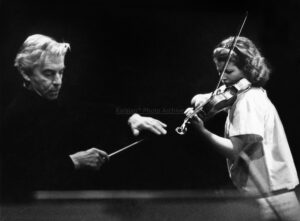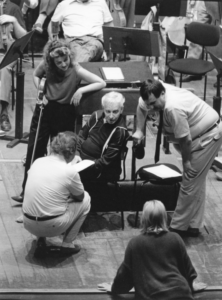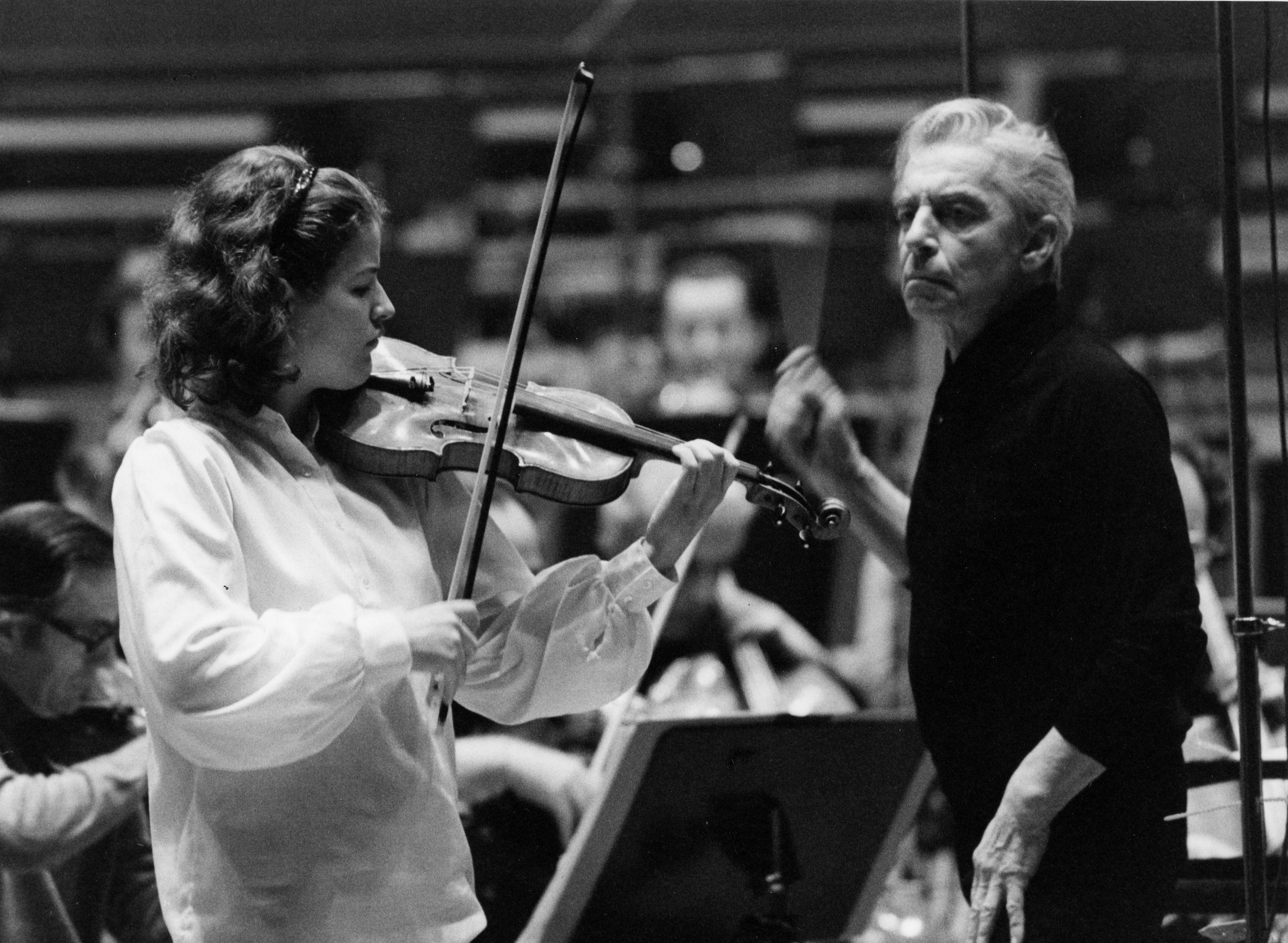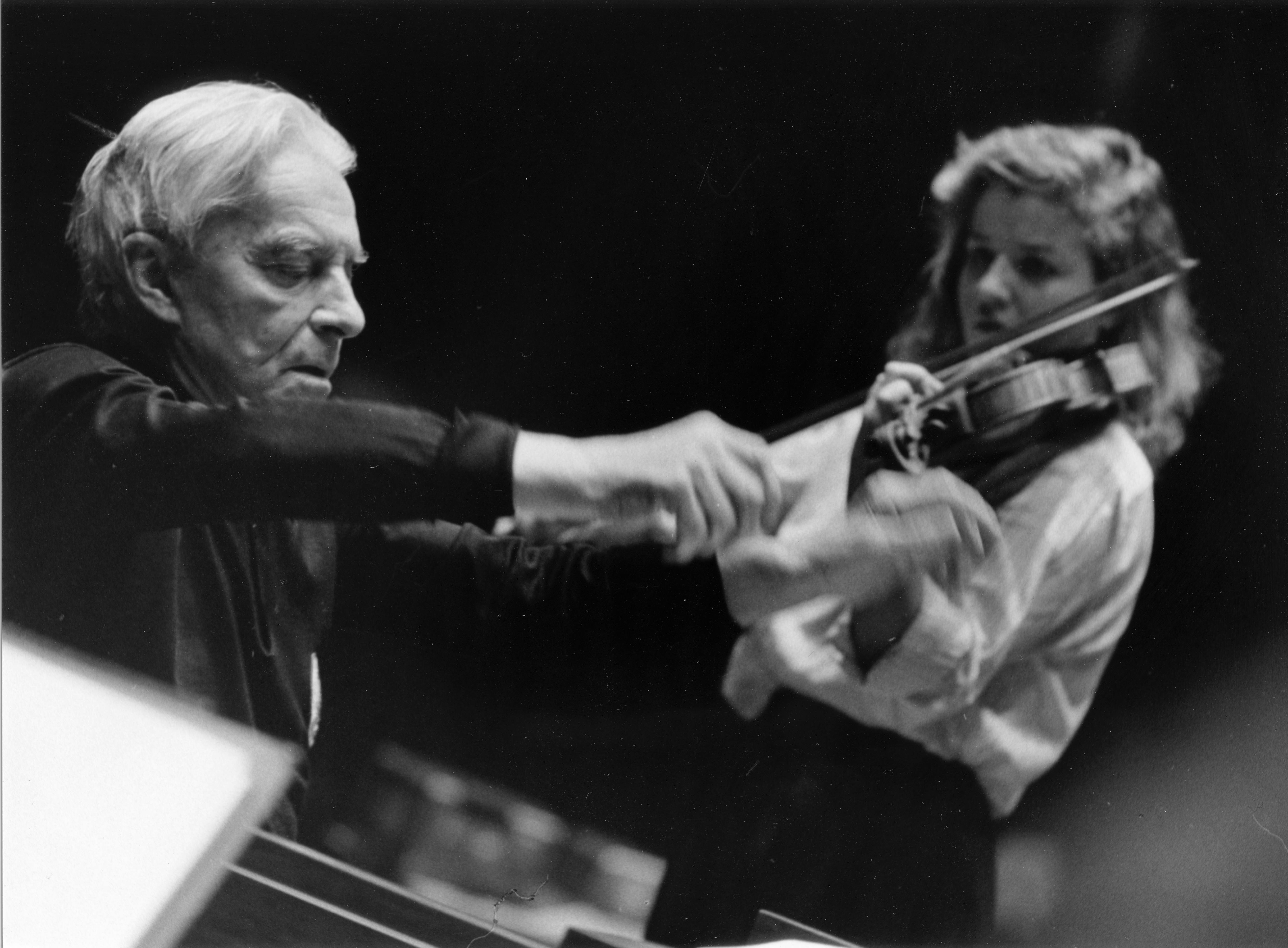29 June 2023
P.R. Jenkins
Karajan artists: Anne-Sophie Mutter – Karajan’s discovery

She is the Karajan protegé par excellence. Anne-Sophie Mutter, one of the leading violinists of our time, started to play concerts with Karajan at the age of 13 and made many recordings with him as a teenager and twen (concertos by Vivaldi, Mozart, Mendelssohn, Brahms, Tchaikovsky and others).
“He was very restrained, almost shy, extremely kind.”
Anne-Sophie Mutter about Karajan

“You can’t say it’s a talent. It’s genius on the violin.”
Karajan about Anne-Sophie Mutter
It all started with Mozart in Salzburg – very suitable for a prodigy. Richard Osborne recalled the first rehearsal with the Berlin Philharmonic: “Eventually, a 13-year-old girl appeared on stage. She was wearing jeans and carrying a violin. Her name was Anne-Sophie Mutter and she was about to make her first appearance with Karajan and the orchestra. The moment the Mozart concerto started, the years seemed to fall away from Karajan. Standing now, no longer perched aloft, his conducting was exact, vibrant, intense. (Richard Osborne)”
“He was the embodiment of charisma.”
Anne-Sophie Mutter about Karajan
The Beethoven violin concerto is a difficult case for every violinist. Karajan “commissioned” it from Mutter shortly after the Mozart concertos. When she played it for him for the first time he said: “Come back with it in a year.” Mutter was a little chastened but began practising again. In the meantime they recorded Massenet’s “Méditation” and – together with Mark Zeltser and Yo Yo Ma – Beethoven’s Triple Concerto, Karajan’s second recording ten years after the one with Rostropovich/Oistrakh/Richter.

In December 1979, Karajan and Mutter recorded the violin concerto in the studio without having it performed live before. Two film versions were to come in the following years.
“My relationship with the [Beethoven] violin concerto is of course so deeply influenced by Karajan that I could play it with him tomorrow and we would continue our musical dialogue exactly at the point where we broke off in the 1980s.”
Anne-Sophie Mutter in 2020
The Beethoven concerto with Anne-Sophie Mutter was also on the programme of Karajan’s encounter with the European Union Youth Orchestra in Courchevel and Salzburg in 1980.

“It’s another one of the many superb collaborations of the two for the yellow label.”
Tal Agam, the Classic Review about the Mendelssohn/Bruch disc
Their next project in 1980 was the recording of two romantic violin concertos. The combination of the Max Bruch and Mendelssohn concertos on disc is as popular as the combination of the Schumann and Grieg piano concertos, especially since Bruch was a great admirer of Mendelssohn.
Bruch (1838 – 1920) was a highly respected German composer, a friend of Brahms and Sarasate, taught Respighi and Vaughan Williams and is known for works like the “Scottish Fantasy”, “Kol Nidrei” and above all for his 1st violin concerto. Although Bruch wrote three violin concertos, “the Bruch concerto” is his first op. 26, a piece that every violinist has in his repertoire and whose popularity cast a shadow on the rest of his work.
It was Karajan’s only studio recording of these concertos.

“The achievement of Mutter in partnership with Karajan is the more impressive and compelling, the more I sample it.”
Edward Greenfield in Gramophone about the recording of the Brahms violin concerto
Continuing to record the great works of the violin repertoire, Karajan and Mutter reached another peak when they started working on the Brahms violin concerto in 1981. Richard Osborne described it like this: “Having taught Mutter to play the Brahms Violin Concerto as though it was chamber music, he threw down the gauntlet by insisting that she record the concerto in two complete takes in a single three-hour-session. The results speak for themselves, intimate yet intensely alive.”
This recording was used as a soundtrack for one of the most impressive films of the early 21st century – “There Will Be Blood” by Paul Thomas Anderson.

The Brahms anniversary in 1983 was a good reason to record another of his works, the Double Concerto with cellist Antonio Meneses (Karajan’s only studio recording of this concerto).

Between 1984 and 1987, Karajan and Mutter dedicated themselves to an all-time favourite, Vivaldi’s “Four Seasons”. The genesis of the different versions took a long time because of complicated negotiations with record and film companies. The CD was published by EMI and featured the Vienna Philharmonic (the photos for the booklet and the media campaign were made by the famous photographer Lord Snowdon). The film was made on the occasion of the inauguration of the chamber music auditorium in the Berlin Philharmonie three years later, I presume this was the last time Karajan played the harpsichord for a recording.
“I saw him dedicate so much time and passion to things I know he had already lived with for fifty years. He truly was a genius who never stopped seeking for more expression, for what he felt was the ideal.”
Mutter to Canadian Broadcasting Corporation in 1989
Karajan’s and Mutter’s last joint concert was recorded live in Summer 1988 and was another cornerstone in their discography – Tchaikovsky’s violin concerto. It was also Karajan’s last-ever concert with the Vienna Philharmonic in Salzburg.

“Mutter said: ’Karajan always arrived two minutes before a concert, so I would arrive two minutes before. He drove a Porsche, so I bought one – except that his was turbo-charged, mine was ordinary.’
At the time Anne-Sophie Mutter bought her first Porsche, she was not yet old enough to drive it. That amused Karajan no end. (Richard Osborne)”
We’ve prepared playlists with Karajan and Anne-Sophie Mutter. Listen to them here.
— P.R. JenkinsRichard Osborne: “Karajan. A Life in Music” Chatto & Windus, London. 1998






















